
As a trainer, it can be tempting to try and solve everything using your weapon of choice…training. Don’t worry, you’re not alone. Most professions with a particular focus, view the world’s problems through that lens. Surgeons want to fix people by cutting out the problem. Psychiatrists want to solve problems by medicating the problem. Bakers think they can make the world a better place through their confections (a slice of pecan pie would make my world better right now…just sayin’). And yes, trainers think they can fix everything with training. NEWS FLASH…they’re all wrong! Yes, we can solve *some* problems with all of these strategies, but we can’t solve all problems with any of them. So as it relates to training specifically (as tempting as it was to write about pecan pie), how do we know when it’s time to employ training and when it isn’t? That’s what we’re here to discuss, and we’ll do so by exploring Gilbert’s Behavior Engineering Model.
Gilbert’s Behavior Engineering Model
To answer the “when should I train” question, we’re going to refer to Gilbert’s Behavior Engineering Model. Thomas Gilbert was a psychologist who was the founder of performance technology. He created the Behavior Engineering Model to help explain potential performance gaps, and we can use it to determine when to focus on training, and when we should focus on other gaps.
Gilbert’s Behavior Engineering Model forms a 2×3 matrix. There are two main influences on performance: the environment in which someone works and their behavior within that environment. These two factors span across three main categories: the information provided, the instruments they’re afforded, and their motivation.
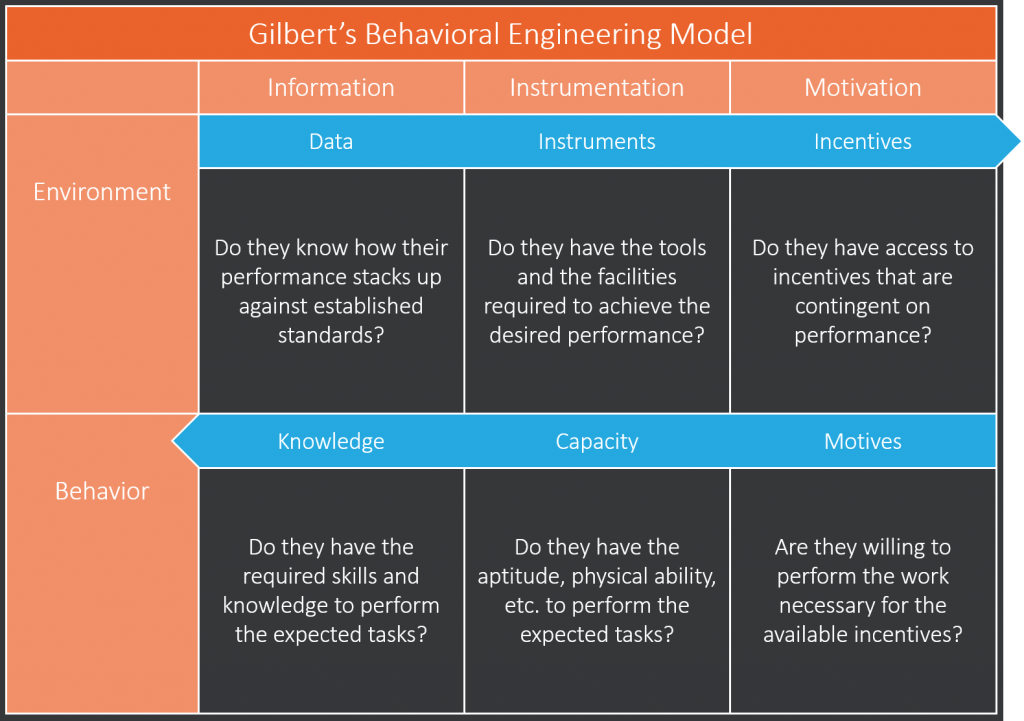
People typically present Gilbert’s Behavior Engineering Model (or the adapted “Six Boxes” model) top to bottom, left to right. (Data, Instruments, Incentives, Knowledge, Capacity, Motives). However, I feel the boxes should be addressed in a clockwise sequence (and when I speak on the topic, I present them as such). As we progress, I’ll describe why I feel each box should be addressed *before* knowledge (which is where you address training needs).
As an analogy, I view the Behavior Engineering Model similar to Maslow’s hierarchy of needs.
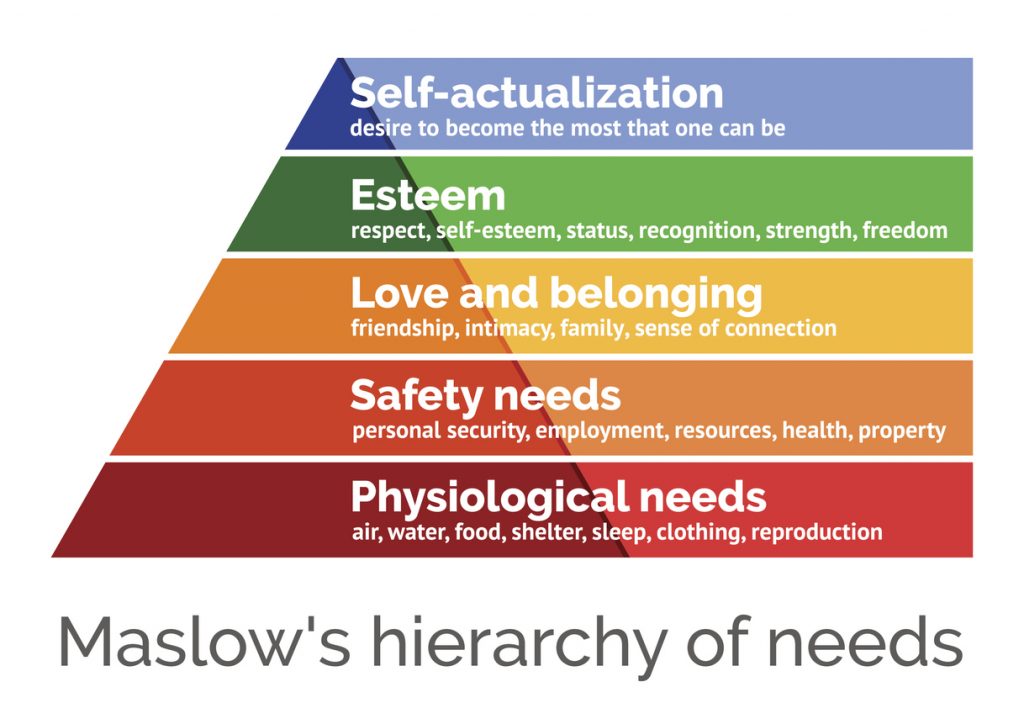
With Maslow’s hierarchy, a person must address the lowest tier of needs before they can focus on anything in the next row up. For example, a human will not worry about their employment (safety need) if they aren’t getting enough air (physiological need).
I treat Gilbert’s Behavioral Engineering Model similarly. Starting at the top left (Data), address each of the 5 boxes before you determine that training is the right solution.
Data
The first stop in the Behavior Engineering Model is Data.
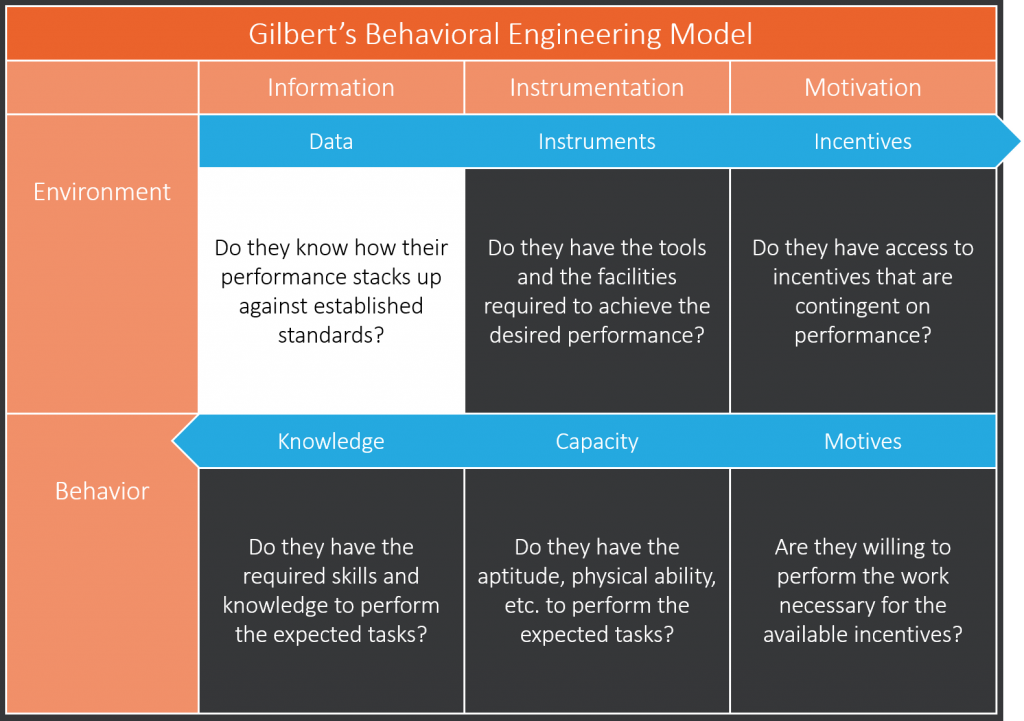
The most important place to start is whether the employee knows how their performance stacks up against any established standards.
Company: “Hey Ms. Employee, did you know you’re supposed to do _______?”
Ms. Employee: “No.”
Employees need to know what’s expected of them. If they aren’t even aware their performance doesn’t meet standards, that’s the place to start. There should never be any misunderstanding regarding how an employee is performing. And furthermore, they should be given guidance about their performance.
Ensure this with frequent and relevant feedback, and a clear description of what’s expected. They should also be provided clear and relevant guidelines regarding adequate behavior. This will ensure they know how they’re performing against the standard.
The bottom line: If employees don’t know their performance is sub-standard, it’s too premature to think about training.
Instruments
If you know the employee understands their performance against the standard, the next consideration pertains to the instruments the company provides to them.
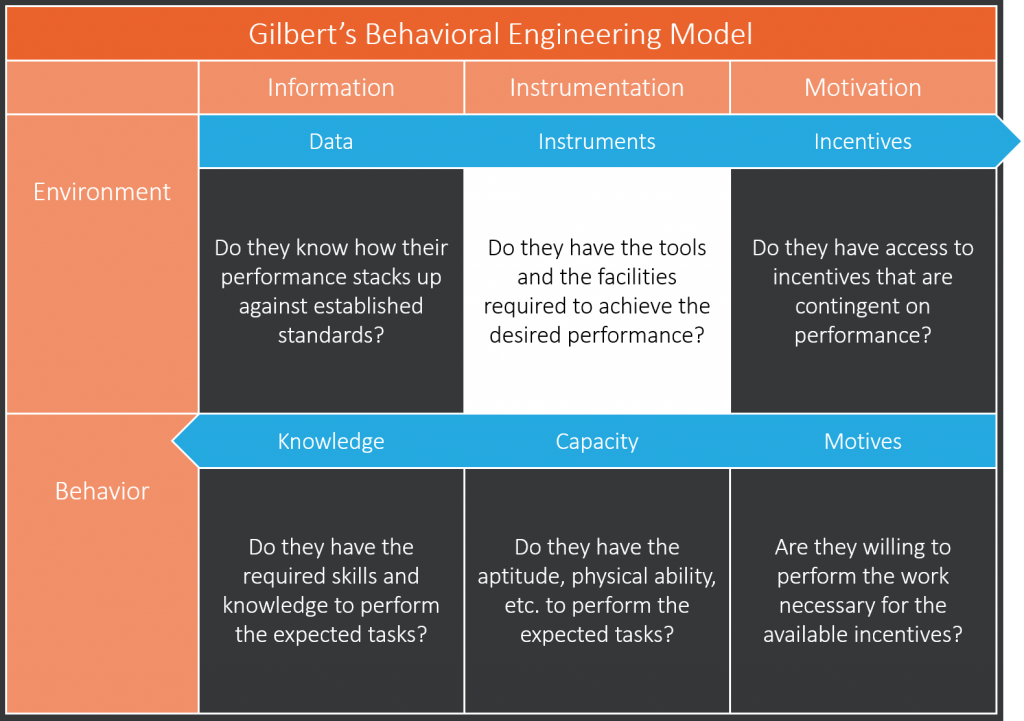
At this stage, focus is on providing the employee the tools and the physical environment necessary to achieve the desired performance. Do employees have the right tools for the job? Is their work environment conducive to their success? You need to make sure both of these support the basic needs of what you expect the employee to perform.
The bottom line: If employees don’t have the right tools for the job, training will not fix that.
Incentives
After that, the incentives the organization has in place come next.
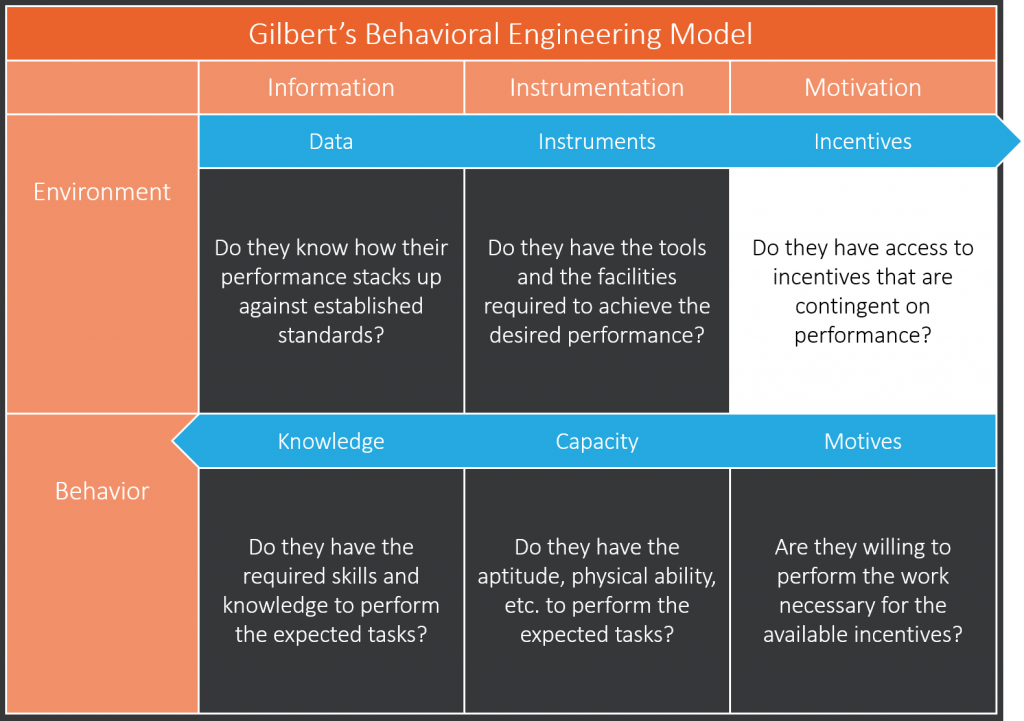
Does the employee have access to incentives that are contingent on their performance? The first thing people think about here is money. While not the only consideration, it is important to consider if there are financial considerations based on their performance. Having money tied to performance is a factor. But there also need to be non-monetary incentives. These could be career advancement opportunities, recognition, etc. What’s important here is that the incentives are tied to performance.
The bottom line: If proper incentives are not in place, new training will not make employees want to perform their jobs.
Motives
Then we move on to the motives of the employee.
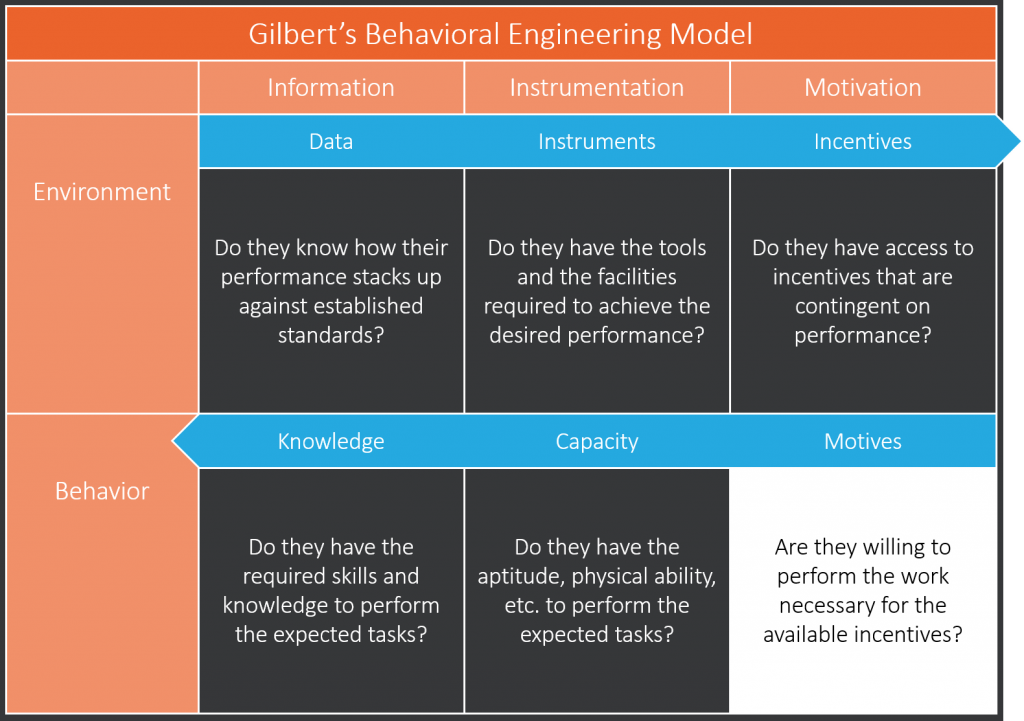
This is the first box where I view the order differently than the norm. Here the focus is on whether the employee is willing to perform the work required for the available incentives. In other words, if you have incentives, are they sufficiently motivating? There are a lot of things that impact motivation levels. Job environment. Company culture. Job fit. The list goes on. Almost all of these don’t have to do with training. And I would argue that these issues need to be addressed / resolved before training has a chance of being successful.
The bottom line: If employees are not properly motivated to do their job, training is not going to make them want to perform better.
Capacity
Next we come to the employee’s capacity for the tasks in question.
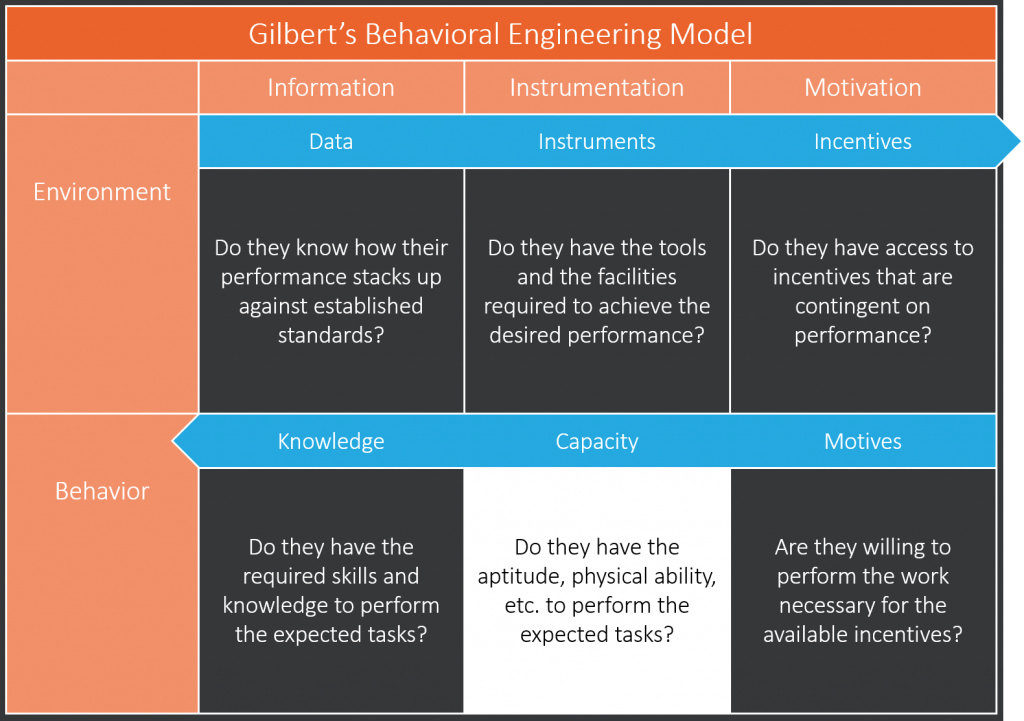
Here is the other box that I present “out of sequence” from the norm. This stage focuses on whether the employee has the aptitude or physical ability to perform the expected tasks. Say my job task was to devise a propulsion engine for a trip to Mars. Or I was expected to High Jump 7 feet. No amount of training will net those results (for me). This category comes more down to employee-job match, which is not a training issue.
The bottom line: If employees literally don’t have the capacity to perform a job, no amount of training is going to change that.
Knowledge
Finally, we get to knowledge.
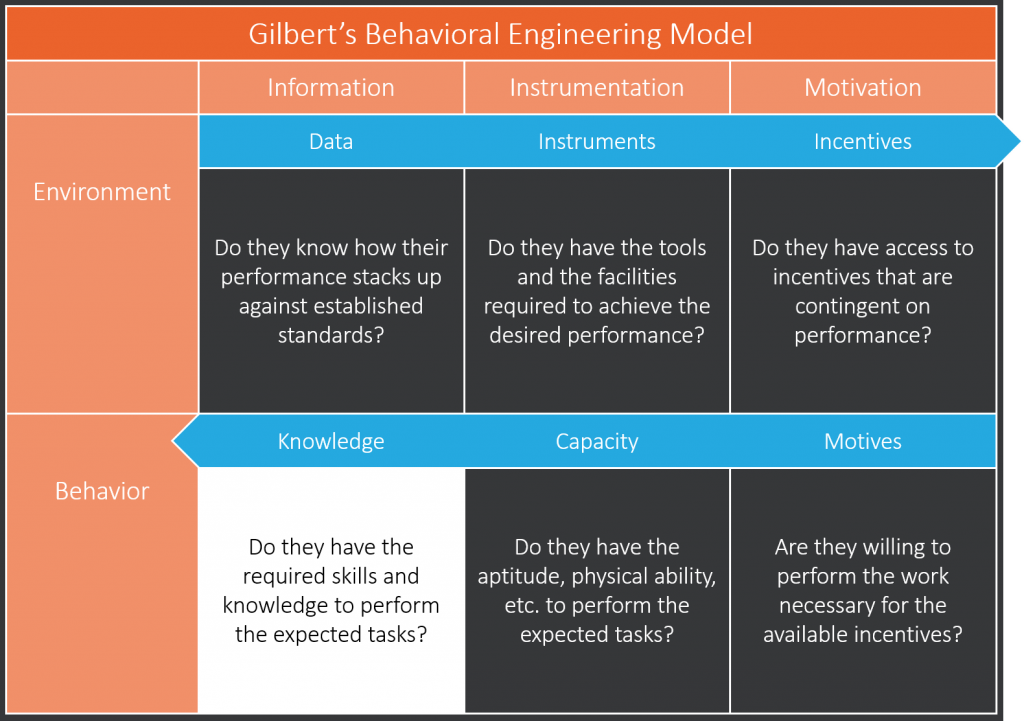
As training professionals, here’s where we typically fit in. Do the employees have the required skills to perform the expected tasks? If not, it sounds like a training need. The problem with any training is that it can be relatively expensive to create. I mean, think back to “data,” the other “information” category. What do you think takes longer? Obviously informing someone of a performance gap is quicker and easier than creating training. Additionally, each of the other 5 categories are more systemic than a training gap.
For example, assume employees don’t have the right tools for the job. Could you create training to work around that deficiency? Possibly! And sometimes that’s required, although not ideal. But if possible, it’s much more efficient to give employees what they need. Having the wrong tools is inefficient. It can also trickle down to impact motivation. So, similar to Maslow’s hierarchy at the beginning, make sure your other bases are covered. Once they are (or if for some reason they can’t be) then focus on training.
The bottom line: If the other 5 boxes are in order, then you know you have a skills gap (training need). Other than certain extenuating circumstances, addressing knowledge without addressing prior stages will not be successful.
Training is Critical, But Not the Only Solution
It probably seems odd for a training vendor to write an article focused on when / why not to train. However, the main point of training is to solve a problem. As a training provider, you need your customers (or prospective customers) to trust you. You need them to be successful. If all you’re doing is order-taking, and throwing training at non-training problems, you’re not helping. So, when training is the problem, create the best training you can. But if something upstream from “knowledge” is the problem, address that first.
